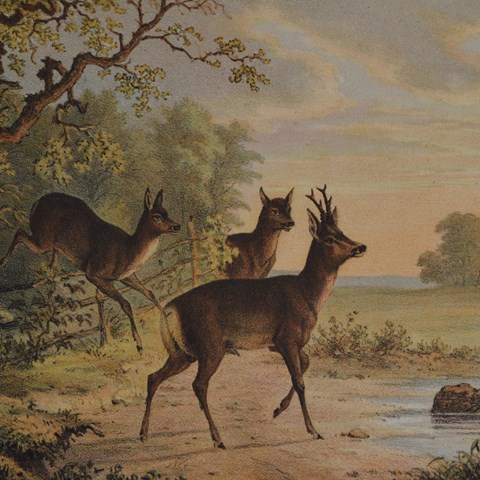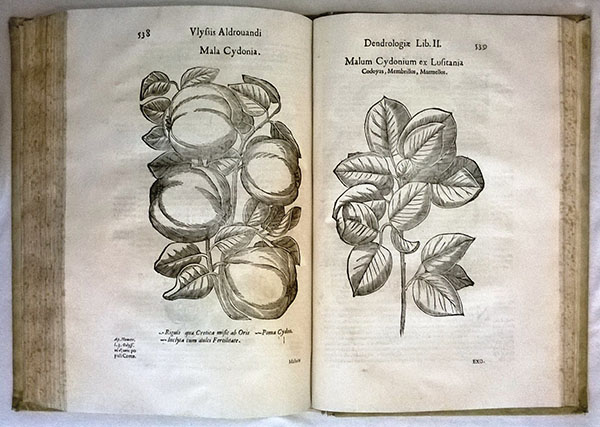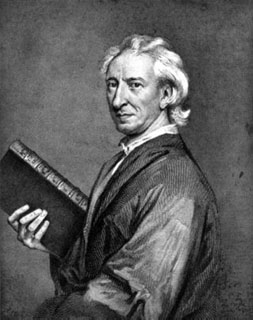Contact
SLU University Library
library@slu.se, 018-67 35 00
Addresses and opening hours

The historical collection at the SLU library in Umeå includes literature from the 1700-1900s. Many of the works have been donated by Gunnar Schotte, the first librarian at what was later to become the Forestry library.
Professor Gunnar Schotte (1874-1925) was the head of the Swedish State Forest Research Center and director of its forest department and from 1918 also the first librarian. With his many contacts around the world he built the forest library and his own book collection.

One of the oldest works at the SLU library in Umeå is Dendrologia naturalis: scilicet arborum historiae libri duo. The work was published 1668 after the author's death.
Aldrovandi was an Italian naturalist who became professor of natural history in Bologna in 1561. He studied systematically mainly plants, birds, insects and other smaller animals. The Pope financed his publications in natural history. Aldrovandi built up his own museum of biological samples that he classified according to his own systems. The museum, the library and the manuscript of his unpublished works were handed over after his death to the city of Bologna.
The work Dendrologia naturalis was very significant in botany. The greatness of Aldrovandi's publications is based primarily on his scientific method. He used his own observations, contrary to his contemporary colleagues who used information from other texts and travelers. He recreated the observations in minituous descriptions. Aldrovandi's knowledge of teaching as well as author of publications that has become irreplaceable and a cultural heritage, has made him considered the father of modern science.
Read Dendrologia naturalis online at Google Books

Evelyn was an English author who lived in the countryside. He wrote publications within art, forest and religion. Throughout his life he wrote diary and it is considered to be very valuable as a source of information about social, cultural and political life in the 18th century England.
Evelyn wrote the work Sylvia on behalf of the English Navy, describing different types of trees, their cultivation and use. The publication was published ten times until the year 1825, with all possible modifications over the years.
In Sylvia, Evelyn urges landowners to plant forests on meager and dry fields. Many followed his call and today his idea of planted forest has become reality in England.
Ströms publication, Förslag till en förbättrad Skogshushållning i Sverige (1822), was the first of its kind to describe in writing the best way to care for the forest. It was used, for example, at the Forest Institute's teaching in forestry for many years.
A few years before publishing this publication on his own, Ström made careful research of the foreign literature to find out how to improve the general forestry. The novelty of his ideas was that certain parts of the forests in Sweden would be managed by the state. These ideas were counteracted by currents that considered the state forest to be in poor condition due to the state's already big influence. The forest should instead be owned and operated by individuals, in whole or in part. This current ended in 1923.
Segerdahl was the daughter of the superintendent and later director of the Royal Forest Institute, Gustaf Segerdahl. In 1868 she shot her first elk and the publication Jakter och minnen (1898) is considered the first hunting book written by a woman. She had a deep love for the forest and the hunt. She is also known as the first female skater in Stockholm!
Bort med bok och broderi! Förspill ej de härliga vårdagarna inom fyra väggar, utan skynda ut i Guds fria natur! Njut af grönska, dofter, färger och lif, i de tusen former, hvari de nu uppenbara sig! Lyssna till den mångstämmiga musiken från luften och trädens kronor, som fyller hela rymden med välljud och harmoni.
This is how her hunting book Jakter och minnen begins. The publication is in a diary form, but also describes and tells what she is doing and who she meets. Her love for the forest and the interest in the hunt becomes true through her poetic and romantic language, when she describes the surroundings and happenings.
The collection reflects the emergence of forest science that had its origin in Germany. Here you will find works by German predecessors like Heinrich Cotta (1763-1844) and Georg Ludvig Hartig (1764-1837). The latter was the founder of the first forest schools, of which a Meisterschule in Dillenberg.
Carl Ludvig Obbarius (1780-1860), was a german antagonist influenced by Ströms who published Tidskrift för skogshushållning, which with its five numbers between 1850-1856 became somewhat more long-lived. Obbarius managed the new forest institute of Brukssocieten and Skogskolan in Västsura, a competitor of the Swedish Forest Institute.
Gustaf Segerdahl (1803-1891) was the director of the Swedish Forest Institute in the mid 1900's. He published several writings, such as Handledning för skogars indelning, afverkning och återsådd med praktiska hänvisningar, 1843, Lärokurs uti skoghushållningen, 1852, and Om svenska skogshushållningens statsekonomiska betydenhet ...,1834.
Conrad Georg Holmerz (1839-1907) was the director of the Swedish Forest Institute between 1892-1904. He developed the teaching there and published textbooks such as Studier i skogstaxation and Vägledning i skogshushållning.
Axel Lundström (1847-1905) was a botanist and professor in Uppsala. He established a forest biological research station in the north of Sweden in 1895 in collaboration with Frans Kempe. Om våra skogar och skogsfrågorna was published in Stockholm 1895.
Thorsten Örtenblad (1855-1917) commissioned several studies in Norrbotten together with C.G. Holmerz in Norrbottens skogar (1886; Bihang till Domänstryrelsens berättelse 1885) and by himself Om skogar och skogshushållning i Norrland och Dalarne (1894; Bihang till Domänstryrelsens berättelse 1893).
Albert Nilsson (1860-1906) was an associate professor of science and botany at the Swedish Forest Institute, where he studied forestry communities and rejuvenation conditions on different fields as well as effects of fires. An example is Växter och myrar. Föredrag vid K. Vetenskapsakademiens högtidsdag den 31 mars 1890. Stockholm, 1890.
Agardh, Carl Adolph (1785-1859). Swedish botanist, economist, politician and educator. Professor of Botany and Practical Economics in Lund 1812-34, Member of the Swedish Academy from 1831 and Bishop of Karlstad from 1835. Father of Jacob Georg Agardh (also he a botanist) and grandfather of the famous swedish writer Gustaf Fröding (!). Systematics and specialist in algae and also pioneer in plant physiology. Together with C.-E. Ljungberg he wrote Lärobok i botanik, 1829-1832, and Försök till statsekonomisk statistik öfver Sverige (1852-63).
Agardh, Jacob Georg (1813-1901). Swedish botanist. He continued in his father's footsteps with algae research. He defended Linnaeus against attacks by the German plant physiologist Julius von Sachs in the writing Om Linnés betydelse i botanikens historia (1878).
Andersson, Nils Johan (1821-1880). Swedish botanist, schoolman, professor and lecturer at the botanical collections of the Natural History Museum 1856-79. Made several botanical trips in Europe and a landslide seal 1851-53. Wrote extensive botanical publications such as Atlas över den skandinaviska florans naturliga familjer, 1849 and Lärobok i botaniken för elementar-undervisningen, 1855.
Fries, Elias (1794-1878). Swedish botanist and teacher to A.J. Retzius and C.A. Agardh. Professor of Practical Economics and Professor of Botany, as well as Principal at Uppsala University. Particularly focused on mushrooms and lava systems. The SLU library has his popular science essays Botaniska utflygter, published 1843-64.
Hartman, Carl Johan (1790-1849). Swedish botanist and provincial physician in Gävle. Wrote the first flora in swedish, Handbok i Skandinaviens flora (1820). The SLU library has the second edition, printed 1832.
Retzius, Anders Johan (1742-1821). Swedish natural scientists in pharmacy, chemistry, mineralogy, botany, country houses, zoology and geology. Professor of Natural History at Lund University 1795-1812. Wrote about the housekeeping of the plants in Försök til en Flora oeconomica Sveciae eller Svenska växters nytta och skada i hushållningen, 1806, and a new, improved edition of Linnaeus Fauna Svecica. Pioneer in Quaternary Palaeontology.
Sachs, Julius von (1832-1897). German botanist and Professor of Würzburg. Pioneering plant physiologist, who wrote Lehrbuch der Botanik (available at the SLU Library). In his history of the botany, Geschichte der Botanik vom 16. Jahrhundert bis 1860, he strongly criticized Carl von Linné, which he claimed had not made a single discovery for the botany.
Vaupell, Christian Theodor (1821-1862). Danish botanist. Much devoted to microscopic examinations and preserved plant parts in peat and plant anatomy. One of his writings is Bögens indvandring i de danske skove, 1857.
Wahlenberg, Göran (1780-1851). Swedish botanist, geographer, geologist and professor of medicine and botany at Uppsala University. Together with Alexander von Humboldt, considered the founder of the western geography. Also a pioneer in plant anatomy and plant physiology in Sweden. One of his writings is Flora Svecica enumerans plantas Sveciae indigenas, 1826.
Nilsson, Sven (1787-1883). Swedish naturalist and archeologist, curator at the Swedish Academy of Sciences zoological museum in Stockholm 1821-31, professor of natural history in Lund 1832-56, became priest and vicar 1838 and prost 1839. Skandinavisk fauna, 1820-1842 (originally with the subtitle En handbok för jägare och zoologer) was the first work of its kind for a wider public. Pioneered in the study of fossils and was one of the first to realize that a general depletion took place in quartile time. He was also an outstanding prehistoric, ethnographer and archeologist. He was the son of a farmer from Skåne (south of Sweden) and he not only hated the wolf but all the predators. He is considered one of our leading zoologists.
Ratzeburg, Julius Theodor Christian (1801-1871). German zoologist, entomologist and forest scientist. Professor of Natural History at Eberswalde Forest School. Considered to be the founder of forest entomology. The SLU library has several of his publications, for example Die Forstinsektecten (1839-1844) and Die Ichneumonen der Forstinsecten in forstlicher und entomologischer Beziehung (1844-1848).
Hunting is the second largest subject area in the historical collection of the SLU library in Umeå. Hunting was an important element in the education of hunters and other forest professionals. The hunt has always been of great importance from the point of view of supply. The preys of big wild animals (elk, deer, deer, bear) and of small wild animals (squirrel, hare, bird) has had great economic value throughout the ages. The trapping methods have varied: beads or hatches, catches and nooses. Some methods were so effective that, for example, the beaver was exterminated at the end of the 19th century because of the high demand for gall (secretion found in scrotum bags at the anal opening). Hunting statutes can be found already in Magnus Eriksson's national law. The oldest hunting literature in the SLU library collection is from the late 1700s, for example Adeliger Zeitvertreiber oder neuerfundene Jagdregrözungen, Augsburg, 1696.
The hunting literature also includes literature about weapons and dogs.
Some of the titles in the collection are:
Brummer, Magnus Henric. Försök til et svenskt skogs- och jaktlexikon, Götheborg, 1789.
Enander, T. Anvisning till handgevärens kännedom, vård och iståndsättande, Stockholm, 1832.
Enander, T. Anvisning till skjutkonsten med handgevär, Stockholm, 1832.
Hahr, Anders Wilhelm. Handbok för jägare och jagtvänner, Stockholm, 1866.
Hahr, Anders Wilhelm. Om de tillförlitligaste medlen att utrota våra skadligare rofdjur och roffoglar, Stockholm, 1868.
Lloyd, Llewellyn. Jagt-nöjen i Sverige och Norrige, Stockholm, 1830.
Lloyd was an Englishman and came here as a fugitive after an illegal hunt where he shot a hunting warden. He was primarily a bear hunter and published books that became the classics of hunting and wilderness depiction, of which the above-mentioned title is the most popular.
Tidskrift för Jägare och Naturforskare, published 1832-1834. Issued by Svenska jägareförbundet that was established 1830. The successor from 1940 is Svensk jakt.
SLU University Library
library@slu.se, 018-67 35 00
Addresses and opening hours